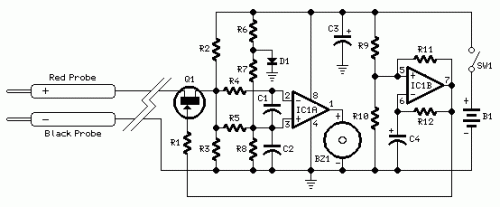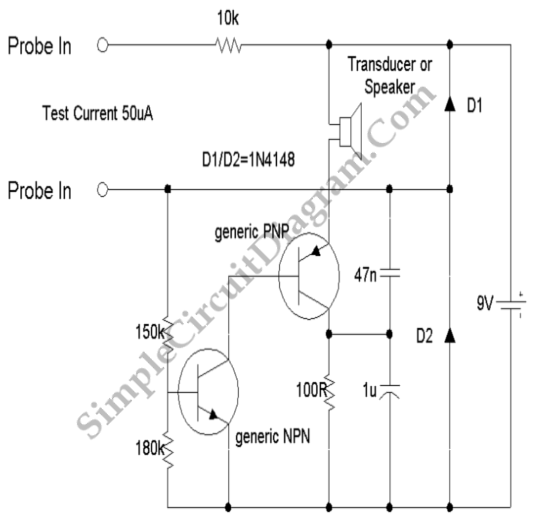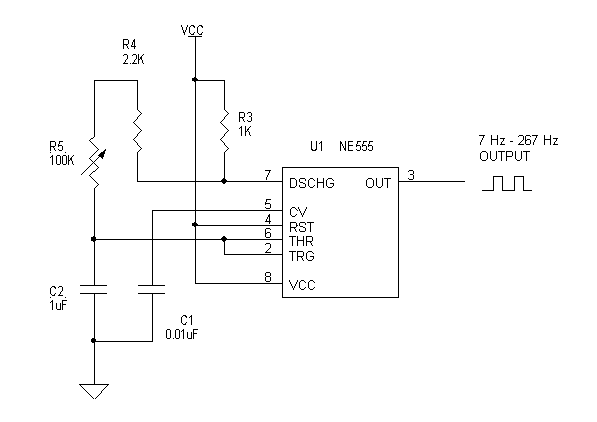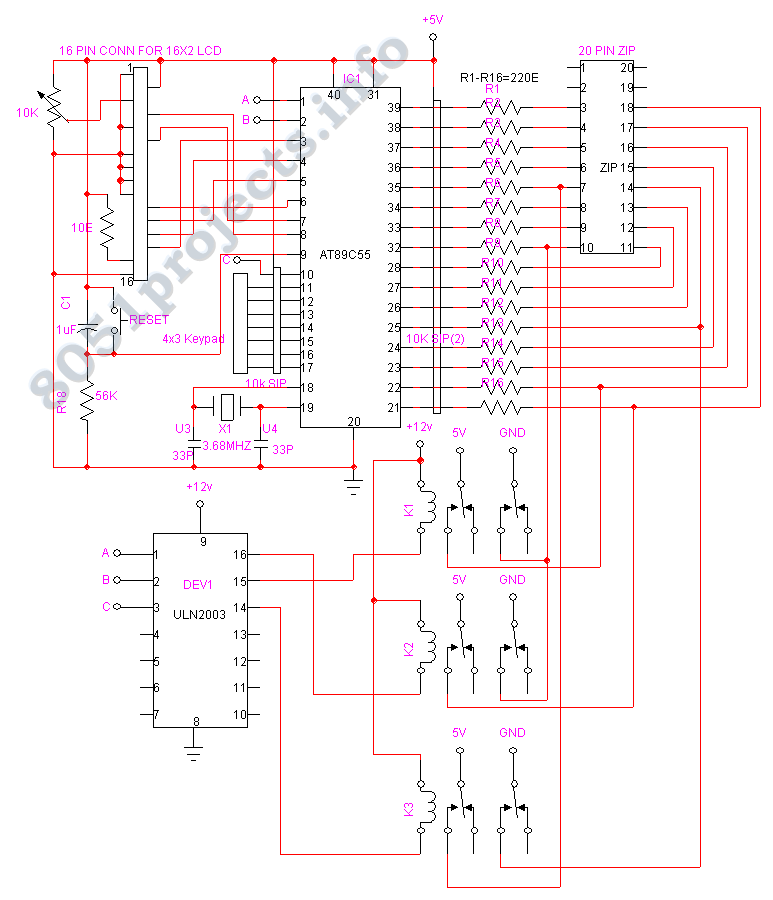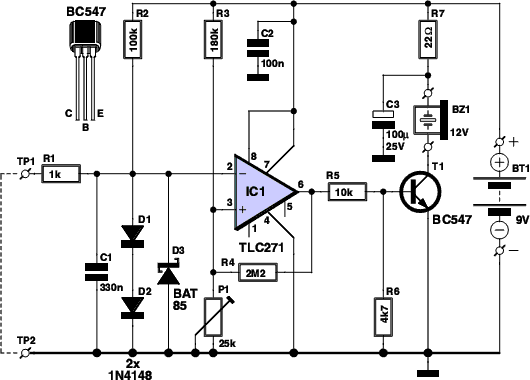
Connection Tester
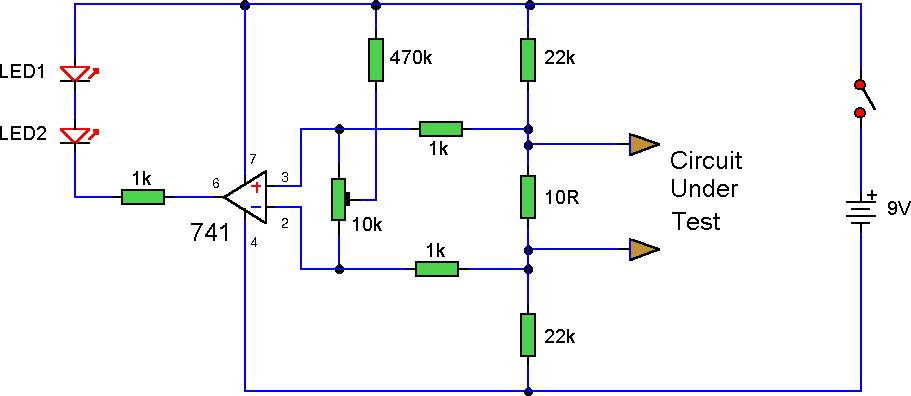
This circuit employs a 741 operational amplifier (op-amp) in differential mode to function as a continuity tester. The voltage difference between the non-inverting and inverting inputs is amplified by the op-amp's full open-loop gain. For the moment, the 470kΩ and 10kΩ control resistors can be disregarded while focusing on the op-amp's inputs. If the resistors are perfectly matched, the voltage difference will be zero, resulting in a zero output. However, the inclusion of the 470kΩ and 10kΩ control allows a small potential difference to be introduced across the op-amp inputs, disrupting the circuit's balance. This potential difference is amplified, causing the op-amp output to reach the maximum supply voltage, thereby illuminating the LEDs. The probes should initially be connected to a resistor with a value between 0.22Ω and 4Ω. The control is adjusted until the LEDs just turn on with the resistance across the probes. After this, the resistor should be removed, and the probes should be short-circuited, which should turn off the LEDs. Due to the extremely low resistance value, it is crucial to keep the probes—whether they are crocodile clips or needles—clean, as dirt can increase contact resistance and lead to circuit malfunction. This circuit is also compatible with MOSFET-type op-amps such as CA3130, CA3140, and JFET types like LF351. If the LEDs do not turn off, a 10kΩ preset resistor should be connected across the offset null terminals (pins 1 and 5), with the wiper of the control linked to the negative terminal of the battery.
This circuit operates by leveraging the differential input characteristics of the 741 op-amp, where small voltage differences can be amplified significantly. The 470kΩ and 10kΩ resistors serve as a means to introduce a controlled offset voltage, allowing the circuit to detect minute differences in resistance. The output behavior of the op-amp is critical for the functionality of the continuity tester; when the probes detect a closed circuit (low resistance), the output voltage swings high, activating the LEDs.
The choice of resistors is essential; the selected values allow for fine-tuning the circuit's sensitivity. As the resistance measured decreases, the output voltage increases, and the LEDs illuminate brighter, indicating a good connection. Conversely, when the probes are shorted, the circuit's output should drop to zero, turning off the LEDs, which provides a clear visual indication of continuity.
In practical applications, maintaining clean probe tips is vital. Any contamination can introduce additional resistance, leading to false readings. Therefore, regular maintenance of the probes ensures reliable performance. The circuit's versatility is enhanced by its compatibility with various op-amp types, allowing users to select components based on availability or specific application requirements. Adjustments to the offset null can further refine the circuit's performance, ensuring accurate readings across a range of resistance values.This simple circuit uses a 741 op-amp in differential mode as a continuity tester. The voltage difference between the non-inverting and inverting inputs is amplified by the full open loop gain of the op-amp. Ignore the 470k and the 10k control for the moment, and look at the input of the op-amp. If the resistors were perfectly matched, then the vo ltage difference would be zero and output zero. However the use of the 470k and 10k control allows a small potential difference to be applied across the op-amp inputs and upset the balance of the circuit. This is amplified causing the op-amp output to swing to full supply voltage and light the LED`s. The probes should first be connected to a resistor of value between 0. 22 ohm and 4ohm. The control is adjusted until the LED`s just light with the resistance across the probes. The resistor should then be removed and probes short circuited, the LED`s should go out. As the low resistance value is extremely low, it is important that the probes, (whether crocodile clips or needles etc) be kept clean, otherwise dirt can increase contact resistance and cause the circuit to mis-operate.
The circuit should also work with a MOSFET type op-amp such as CA3130, CA3140, and JFET types, e. g. LF351. If the lED`s will not extinguish then a 10k preset should be wired across the offset null terminals, pins 1 and 5, the wiper of the control being connected to the negative battery terminal. 🔗 External reference
This circuit operates by leveraging the differential input characteristics of the 741 op-amp, where small voltage differences can be amplified significantly. The 470kΩ and 10kΩ resistors serve as a means to introduce a controlled offset voltage, allowing the circuit to detect minute differences in resistance. The output behavior of the op-amp is critical for the functionality of the continuity tester; when the probes detect a closed circuit (low resistance), the output voltage swings high, activating the LEDs.
The choice of resistors is essential; the selected values allow for fine-tuning the circuit's sensitivity. As the resistance measured decreases, the output voltage increases, and the LEDs illuminate brighter, indicating a good connection. Conversely, when the probes are shorted, the circuit's output should drop to zero, turning off the LEDs, which provides a clear visual indication of continuity.
In practical applications, maintaining clean probe tips is vital. Any contamination can introduce additional resistance, leading to false readings. Therefore, regular maintenance of the probes ensures reliable performance. The circuit's versatility is enhanced by its compatibility with various op-amp types, allowing users to select components based on availability or specific application requirements. Adjustments to the offset null can further refine the circuit's performance, ensuring accurate readings across a range of resistance values.This simple circuit uses a 741 op-amp in differential mode as a continuity tester. The voltage difference between the non-inverting and inverting inputs is amplified by the full open loop gain of the op-amp. Ignore the 470k and the 10k control for the moment, and look at the input of the op-amp. If the resistors were perfectly matched, then the vo ltage difference would be zero and output zero. However the use of the 470k and 10k control allows a small potential difference to be applied across the op-amp inputs and upset the balance of the circuit. This is amplified causing the op-amp output to swing to full supply voltage and light the LED`s. The probes should first be connected to a resistor of value between 0. 22 ohm and 4ohm. The control is adjusted until the LED`s just light with the resistance across the probes. The resistor should then be removed and probes short circuited, the LED`s should go out. As the low resistance value is extremely low, it is important that the probes, (whether crocodile clips or needles etc) be kept clean, otherwise dirt can increase contact resistance and cause the circuit to mis-operate.
The circuit should also work with a MOSFET type op-amp such as CA3130, CA3140, and JFET types, e. g. LF351. If the lED`s will not extinguish then a 10k preset should be wired across the offset null terminals, pins 1 and 5, the wiper of the control being connected to the negative battery terminal. 🔗 External reference
